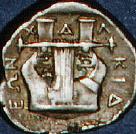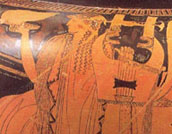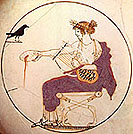Kithara



A stringed instrument, commonly used as an accompaniment to recitation, as of
Homer, by a `kitharode' dressed in a long garment. Less commonly used for lighter recitals, as of lyric. It is distinguished from the
lyre and similar instruments by having a large, rectangular sound box, and elaborate angled arms to accommodate the complicated tuning. It was usually supported by a sash over the performer's forearm. It is seen in the hands of mortal musicians and, as here on the right, of the god
Apollo.The phorminx is a simpler version with rounded arms and smaller soundbox.
Above left: Silver coin minted by the Chalcidian League, about 400 BC. © Oxford, Ashmolean Museum, Heberden Coin Room.
Above middle: Detail from an Athenian red-figure clay vase, about 460 BC. Ferrara, Museo Nazionale di Spina 1685 © Museo Nazionale di Spina
Above right: Detail from an Athenian white-ground clay vase, about 480 BC. Delphi, Archaeological Museum 8140. © Delphi, Archaeological Museum


